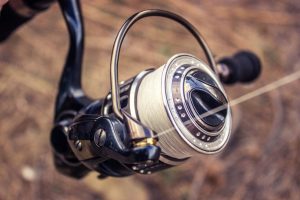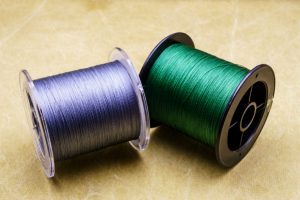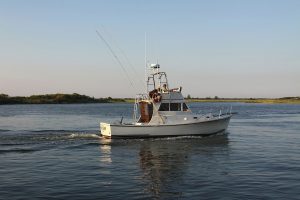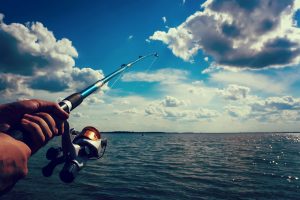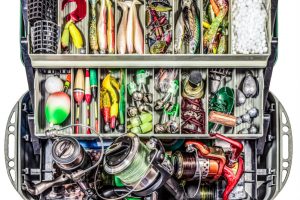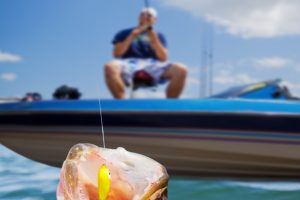
A fish finder can be an excellent tool for a number of different reasons. They can help you find where the fish are hiding as well as any other objects under the water that may affect your fishing trip. When you’re shopping for a new fish finder, it’s important to keep in mind that there are two parts to the fish finder that are important to make sure you’re able to see what’s beneath your boat efficiently and easily.
These two pieces are the display and the transducer. The display is the small screen that you keep on board your boat which will show you what’s going on beneath the boat. The part that allows you to see these details is the transducer, which is attached to the bottom of your boat and sends out a signal to discover everything going on under the water. There are three kinds of transducers that attach to your boat in different ways depending on what is best for your craft and your personal preference. This article is going to go over the transom mount, through hull mount and in hull mount so that you can gain some insight on how to mount each type.
Transom Mount Fish Finder Transducer
The transom mounting transducer is the most popular choice when it comes to transducers. They tend to be less expensive because they are easier for companies to create. They also tend to be more versatile. These transducers are made to stick on the transom and stick out beyond the hull. When you’re installing a transom mount, it’s important to find a way to mark the mounting holes on the transom that will offer the most stable positioning, without a lot of turbulence or movement while it is in the water.
You will need to fix your transducer to the edge at the bottom of the hull because this is one portion that will always be under the water, even when the boat is on a plane. The next step will be to select a drill bit that matches the diameter of the screws that have been included in your mounting kit. Then, drill holes about one inch deep at where you left your marks and line up the bracket with those holes. You’ll then want to fix your transducer to the transom using the screws provided, leaving them just loose enough that the transducer can be adjusted as needed.
Through Hull Mounting of Transducer
Through hull transducers are considered to be the most powerful of the transducer options. They tend to be more sturdy and offer more performance and a greater area of range. If you opt for this kind of transducer, it’s a wise idea to hook it up before installing it to make sure it works well. Afterwards, you can begin the process of getting it on your boat. Like any other transducer, you want the through hull transducer to be as near to the center line of the boat as is possible.
Make sure to keep any other protrusions away from the transducer because they can affect how well it works. You want the transducer to be as flat as you can get it, and oftentimes you can find that the hull is angled. This can be fixed by using a leveling block to help allow the transducer to sit flatly. Once you’ve decided where to put it, drill a pilot hole that is going to be big enough to allow the transducer cables to travel through. Once you get the cords through, fill the pilot hole, leveling blocks and sealant used to hold the transducer and leveling blocks in place and screw a nut onto the stem carefully.
In Hull Transducer Mounting
The in hull transducer is thought to be the easiest to install, and also comes with the benefit of not adding any drag to your boat. You won’t need to drill any holes, but you will need to make sure your hull is made of fiberglass so that the signals from the transducer can get through easily. Also keep in mind that the signal may not be as powerful as other options because the hull will absorb a small amount of the signal.
To install an in hull transducer, pick out an ideal adhesive sealant that you can use to attach the transducer to the hull. Choose the location of your transducer carefully and then add a thin layer of your sealant to the bottom of the transducer. Then you’ll want to attach it to the hull be pressing firmly and constantly. Once you’ve gotten the transducer settled, place a heavy object on top of it to continue pressing it down and leave it for two to three days until the sealant is able to dry. At this point, it will be extremely difficult to remove so it’s important that you be careful when choosing where to place the transducer.
Conclusion
There are a number of ways you can affix both your display and transducer so that you can have the ideal setup for the fish finder on your boat. You can choose to have a display that is easy to remove from the mount so that you can keep an eye on the fish from anywhere on the boat or keep it on a fixed mount in a location where you’ll be able to see it from anywhere on the boat.
The transducer has three different options that will allow you to get the most out of your fish finder. The transom mounting transducer is the least expensive option and is able to attach to the transom. The through hull transducer is thought to be the most powerful of the transducer option and can offer the greatest range, but can be the most difficult to install. The in hull transducer can be the easiest to install, but they have the potential to lose some signal power through the hull and you will need to make sure you have a fiberglass hull as the signal may not be able to travel through other kinds of materials.





